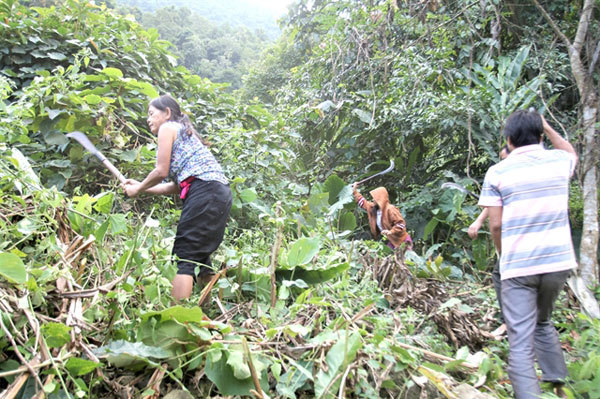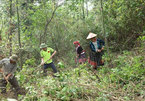 |
|
People in the rural commune Nam Pin, Nam Nhun District, the northern mountainous province of Son La, clear the vegetation in the forest to make a buffer zone to prevent the spread of possible fires during the dry season 2019-20. The people here are beneficiaries of the Government's payments for forest environmental services.
|
This financial source has helped to ensure sustainable forest management, biodiversity conservation, job generation, sustainable livelihoods and people’s awareness improvement, according to Nguyen Chien Cuong, an official of the Vietnam Forest Protection and Development Fund (VNFF).
In the past 10 years, the total payment for forest environmental services reached VND16.75 trillion (US$721 million), 18.2 per cent of the total investment in the forestry sector, Cuong said at a meeting to review 10 years of implementing the forest environmental service fees.
The forest areas collecting the fees increased to 6.8 million hectares this year from nearly 1.4 million hectares in 2011, of which special-use forests make up 18.8 per cent, protection forests 40.5 per cent and production forests 40.7 per cent.
Beneficiaries of the forest environmental services are households, communities, and organisations who signed forest protection deals with the Ministry of Agriculture and Rural Development, said Cuong.
A Tin in Dak Koi Commune of Kon Ray District of the Central Highlands Province of Kon Tum said his family earned VND20 million (US$860) annually from the service and he used the money to expand rice production.
Ho Thanh Hoang, director of the VNFF of Kon Tum Province, said: “The collection of forest environmental service fees had gradually improved people's lives, raised responsibilities of forest owners in forest management and protection, and increased the number of households, groups of households and communities involved in protecting forests.”
“Additionally, the policy has mobilised a large resource for regular forest patrol and protection,” Hoang added.
The policy had also enhanced community engagement in forest protection and contributed to rapidly reducing the number of poor households and ensuring social welfare in residential areas, especially in remote areas of the province, he said.
The policy also positively impacted the responsibility of local authorities and forest owners towards forest protection and development.
The forest owners had worked with local authorities to enhance forest protection measures such as patrolling and detecting illegal loggers.
According to Pham Hong Luong, director of Cat Tien National Park, for the past 10 years, violations of forest protection and development rules had dramatically reduced.
The forest environmental services had a great impact on attracting more people to participate in forest protection and development, Luong said.
The revenue from forest environmental services accounted for about 27 per cent of the total funding for all activities of the park, he said.
“Whether forest protection is successful or not, the livelihood of people living around the forests must be guaranteed,” the director.
“Forest environmental services have contributed to improving livelihoods for people, mainly the poor,” he added.
Shortcomings
According to Cuong, the collection of the forest environmental service fees did still have shortcomings.
The fees of VND36 per kWh of electricity imposed on hydropower production entities and VND52 per cu.m of water levied on drinking water production establishments were so tiny compared to the services created by the forests, Cuong said.
There was a disparity in payment rates among provinces because they depended on forest users and locations, Cuong said.
Besides, there were several fees not regulated such as carbon sequestration and storage services and providing animal breeding grounds.
“For 2021-2030, it was necessary to expand the fee beneficiaries and payees as well as adjust the distribution of forest environment service fees among provinces in the same river basin and increase the rates of fees,” Cuong said.
Regarding fee payees, it was necessary to expand to establishments of ecotourism service, industrial production, aquaculture production such as raising organic shrimps under the mangrove canopy, raising fish in cold water and in cages in rivers and lakes, carbon capture and storage services, and selling carbon credits to the world market.
On the other hand, fees for re-planting forest should be lowered to get more people involved in the activity.
It was necessary to improve legal framework to increase revenues from various types of forest environment services, strengthen facilities to improve the quality of forest database management, offer incentives for forest re-planting such as land use rights and bank loans for forest growers, Cuong added. VNS

Forest environmental services policy changes the lives of northwestern people
Vang A Chinh, head of the Sin Suoi Ho Village, enters the forest every day to check a forest area that he was allocated to look after in 2012 by the forest management board in Sin Suoi Ho Commune, Lai Chau Province.

More efforts needed for forest protection: expert
Vietnam has abundant forest resources, but there are many ongoing problems relating to forest protection. Trieu Van Hung, Chairman of the Vietnam Forest Science Technology Association, talks to Viettimes about the issue.